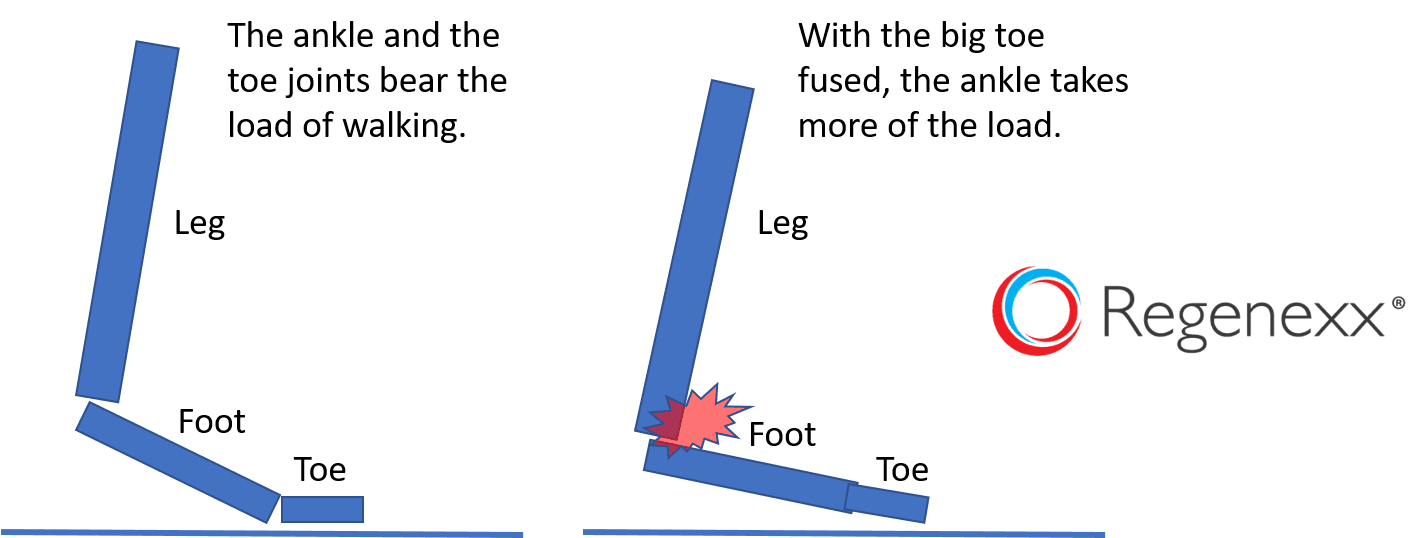Toe Joint Fusion Recovery: One Patient’s Story
On this page:
This week I met a patient who had a toe joint fusion. However, this was a disaster of sorts. The good news was that her toe felt better, but the bad news was that her ankle felt worse. Why? Because her toe joint fusion recovery was a long-drawn-out process that forced energy from her toe to her ankle. Let me explain.
Big Toe Arthritis and Hallux Rigidus
Big toe arthritis for some of us happens as we age. It’s more common in women, and we’ve observed it’s more common in people with chronic low-back pain. When it gets bad, it can result in lost range of motion in the metatarsophalangeal (MTP) joint, and the medical term for this is hallux rigidus (Latin for rigid toe) (1).
For some bizarre reason, one of the treatments is to fuse the MTP joint solid with one or more screws. As with any fusion, this surgery is a dog with fleas.
Problems With Toe Joint Fusion
Surgically fusing joints together has become big business over the last two decades. From a business standpoint, you can take a medical screw or plate made in China for $5 and sell it for $1,000 or more. Given those profit margins, there is an entire army of orthopedic sales reps who sell this hardware to surgeons and hospitals. Hence, given the business plan, it’s not surprising that fusion surgery has become so popular.
I always tell my patients that a fusion is a dog with fleas. Meaning that while the surgery can sometimes help one problem by making it not move, it usually causes others. In the spine, there’s a name for this problem: adjacent segment disease, or ASD (2).
This diagnosis means that once you fuse two vertebrae solid, the forces that should have been handled by that area get shunted to others, which break down more quickly. I don’t know what’s more medically screwed up, that we are aware that fusing one area can hurt others or that it’s so common that we had to create a medical diagnosis for the problem.
A Patient’s Story
The woman I saw this week was actually in to have her low back treated. During that visit, she mentioned that her right ankle was hurting. She also recounted how a big toe fusion recovery that she endured was awful in that it took a full year before she felt somewhat normal. She also stated that a few months after her big-toe fusion, the ankle began to hurt. Her ankle was tender and so was her big toe, despite the fusion.
So I explained what I have drawn in the picture above. That fusion of the big-toe joint was transmitting forces up the kinetic chain to the ankle, so it wasn’t surprising that her ankle now hurt. Given that there is no way to undo the big toe fusion surgery, outside of treating her ankle to keep it hanging in there, there was no solution to that issue.
The upshot? Big toe fusion recovery often includes new places that crop up with pain. Not all patients put two and two together, and in this patient’s case, her surgeon came up with an explanation for her ankle that avoided the obvious.
However, when you fuse the big toe, that energy has to go someplace. Also, this alters your gait in ways that can’t easily be fixed. Hence, don’t immediately buy in when a fusion is recommended, and get lots of opinions. While there are a few medical problems that truly need a fusion, based on my experience, this surgery should never be used as a way to commonly treat pain with surgery.
__________________________________________________
References
(1) Otter SJ, Lucas K, Springett K, et al. Foot pain in rheumatoid arthritis prevalence, risk factors and management: an epidemiological study. Clin Rheumatol. 2010;29(3):255-271. doi:10.1007/s10067-009-1312-y
(2) Virk SS, Niedermeier S, Yu E, Khan SN. Adjacent segment disease. Orthopedics. 2014;37(8):547-555. doi:10.3928/01477447-20140728-08

NOTE: This blog post provides general information to help the reader better understand regenerative medicine, musculoskeletal health, and related subjects. All content provided in this blog, website, or any linked materials, including text, graphics, images, patient profiles, outcomes, and information, are not intended and should not be considered or used as a substitute for medical advice, diagnosis, or treatment. Please always consult with a professional and certified healthcare provider to discuss if a treatment is right for you.

